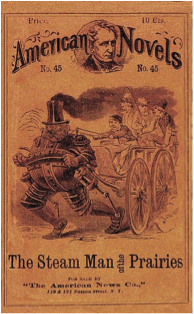The Steam-Powered Robot of 1868
When P.T. Barnum’s American Museum burned to the ground on March 3, 1868, New York City’s residents might have worried that they had lost their primary source of the fantastical and extraordinary amid their everyday lives. But in only a few short weeks, the fantastical returned to Broadway, led by a 22-year-old inventor named Zadoc Dederick and his Steam Man.
Though the Steam Man wore a fancy mustache, gloves, and a vest and jacket, he was a man in only the loosest sense of the word. Beneath that fashionable exterior thrummed a steam-powered contraption designed to pull a carriage on a pair of mechanical iron “legs” — a sort of rickshaw-driving golem. The fancy duds and overall human shape, Dederick claimed, were camouflage to avoid frightening horses in the street.
While those who enjoy steampunk literature and fashion dwell in a world of “retro-futurism” — reimagining the steam-powered science fiction of the 19th century — they sometimes overlook the inventors of the time who attempted to turn fiction into fact. Sure, Zadoc Dederick’s steam-powered man (and his plans to build stallions) did not take off as he had hoped. But as the following article (excerpted by the Post from the New York Express on March 21, 1868) reveals, this young man showed the same kind of imagination and ambition that we still prize in the scientists and inventors of the 21st century.
The Steam Man
He Arrives in New York and Astonishes the Metropolitans.
The inventor and exhibitor of the Newark steam man, Mr. Zadoc Dederick, has improved the occasion of the Barnum fire excitement by hiring rooms in the opposite house, on Broadway, for the purpose of exhibiting this eighth wonder of the world. As a speculative enterprise the idea must have been a success, for at 10 o’clock this morning a large number of persons had congregated at the door clamorously seeking admission. Amongst those who sought admission was one of our reporters, who thus describes his interview with this last specimen of the genus homo :—
Mr. Steam Man is a person of commanding presence, standing seven feet nine inches in his stocking vamps, weighs 500 pounds, measures 200 inches round the waist, and [is] decidedly bucolic in general appearance. At this early hour in the morning he was rather in dishabille, and minus his pants. This circumstance, though detracting rather from his comeliness, was yet more than counterbalanced by the greater facilities it gave for the study of human anatomy, and was eagerly availed of for that purpose. The legs are made of iron cranks, screws, springs ad infinitum, not quite as attractive in exterior as those we see in the weekly pictorials, but evidently of greater durability and strength. The motion of the legs is almost fac simile to that of the human extremities, and the manner in which they are set agoing strikingly calls to mind the philosophic apostrophe of the human donkey to his namesake, “How fearfully and wonderfully we are made.” The abdominal region is occupied by a good-sized furnace, which was in full blast. The steam man’s boiler is delicately concealed from the profanity of the public gaze, but is presumed to be somewhere above the furnace. This complex piece of machinery once got out of order, but was happily restored after a careful investigation of the cause and the application of the appropriate remedy. The steam whistle is fixed in his mouth, the gauge at the back of the head, and the safety valve in an appropriate position. He wears a large stove-pipe hat — stove-pipe literally, for it is through the cranium the funnel passes. His hands are gloved, a good moustache ornaments his face, and in outward garb he is rather good-looking than otherwise.
The steam man proper is but the figurehead, as it were, of a handsome phaeton, capable of accommodating four persons, together with a tank to contain half a day’s supply of water and a bunk for a day’s coal. The entire driving machinery is at the rear of the steam man and within easy grasp of the driver seated on the front seat, who at any time can increase or diminish the speed, turn, stop, curve, etc. Twenty pounds of steam will set the man in motion, and twenty cents’ worth of coal will work him for a day — so the inventor avers.
It was the original intention of Mr. Dederick to have exhibited the steam man to-day in full running motion, but this he says would not be permitted by the insurance company. He says that he can easily accomplish a mile in two minutes on a level course, and offers to test this on Long Island Course as soon as the weather gets fine. The engine is four-horse power, and the man takes thirty inches in each stride. Perhaps the most extraordinary attribute of the animal is the faculty of stepping over all obstructions not higher than a foot. (Of course, all these assertions are the inventor’s, and not the result of the reporter’s investigations.) It or he may be detached from a phaeton, and yoked to a sleigh or any kind of wagon. Mr. Dederick is ready to procreate steam men at a cost of $300 apiece. He will also shortly produce a steam horse adapted to plowing and the heavier kinds of draught and burden. Whether the steam man prove of any practical good or not, he is unquestionably a great curiosity. —New York Express
 It seems Dederick’s imagination was contagious. Later that same year, and doubtless inspired by Dederick’s invention, Edward Ellis published The Steam Man of the Prairies, which is widely considered the first science fiction dime novel in the United States.
It seems Dederick’s imagination was contagious. Later that same year, and doubtless inspired by Dederick’s invention, Edward Ellis published The Steam Man of the Prairies, which is widely considered the first science fiction dime novel in the United States.